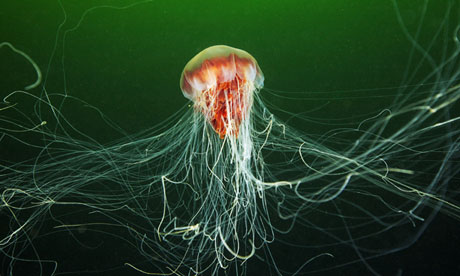
In these days of high summer, as we reconnect with the seaside, it is time to celebrate the beauty of jellyfish. Eerie and almost ethereal, they float through the ocean, rising and falling like the warmed wax blobs in a lava lamp. Officially, because it has no strong means of self-propulsion (beyond a lackadaisical expanding and contracting of its gelatinous skirts), the jellyfish is actually one big bit of zooplankton, subject to currents and upswellings, a nomadic organism roaming the world's wide blue waters in a dreamy existence of its own. Would it not be wonderful to be a jellyfish?
This week's news, that British shores are being inundated by hordes of marauding jellyfish, might scare some people out of the water, but to my mind, it is a welcome invasion by one of the ocean's most mysterious animals.
Of course it can sting – how else would such an aimless creature feed itself, but by the happenstance of its colourful tentacles? That is part of its power in our imagination – its apparently insubstantial form, coupled with its potent effect. In Australia, for instance, should you merely brush against a box jellyfish (Chironex fleckeri), which can reach up to 3m in length and is common off the shores of the Northern Territory, you could suffer cardiovascular collapse and death within two to five minutes.
Closer to home, the most notorious of all jellyfish in European waters is the infamous Portuguese man-of-war, Physalia caravella, so-called because it is supposed to resemble a naval ship at full sail. Yet even here the animal labours under a misapprehension, since the man-of-war is not actually a jellyfish at all, but a colony of zooids. It is also an exquisite creation, a clear, blue-tinged bladder, vaguely the size and shape of a rugby ball, with the addition of an outrageous purple frill.
Out with the sperm whales of the Azores, I've watched these beauties drift by, occasionally rather pathetically blown over by a gust of Atlantic wind. I've even held one in the air, its purple tentacles dangling like prolapsed piles, knotted and wobbling impotently before being lowered back into the water. One brush with those venom-filled nematocysts and I would be very uncomfortable indeed.
Anyone addicted to swimming in the sea will have had their own encounters with jellyfish – from a Scottish loch to a Jamaican cove where, during a midnight skinny-dip, I felt a distinct stab to my leg, and realised afterwards that I'd been stung by a sea wasp. Our Caribbean housekeeper had a remedy: bread soaked in milk.
The beauty of jellyfish has acquired a sense of abstract allure; like butterflies, they seem to swim between art and science. In the mid-19th century, Leopold and Rudolf Blaschka, a father-and-son pair of Dresden glassmakers, created fabulously exact models of jellyfish, so realistic as to be barely distinguishable from the real thing.From 1866 to 1889, London's Natural History Museum purchased 185 Blaschka models (including anemones, squid and corals), and Harvard's Museum of Comparative Zoology acquired more than 400 specimens at the same time, which remain on display in wood-cased vitrines, the coloured and colourless glass glinting like impossibly convoluted confections from a fantastical, subaquatic sweet factory. (Some Blaschka models are currently on display at Nottingham Contemporary's ocean-inspired show, Aquatopia.)
Caught in the netherworld of the open ocean – is it a plant, or an animal? – the jellyfish's ambiguity has the ability to unsettle. The moon jellies that I've seen assembling in Cape Cod Bay, for instance, resemble milky opals dropped into the blue-grey. They are a prime resource for turtles; indeed, the warming seas around the British Isles responsible for this week's reports are also encouraging loggerhead turtles, the largest of their kind, to make forays into our coastal waters, munching away on jellyfish much as we might work our way through a bag of wine gums.
Our most common jellyfish is the "common jellyfish" (Aurelia aurita), with the diameter of a dinner plate and four dangling "mouth-arms", and crescent-shaped purple reproductive organs visible through its semi-transparent "umbrella". It's this jellyfish that you're most likely to see stranded at low tide in great numbers, as though someone had been engaging in a mass Frisbee-throwing contest. It can give you a nasty sting, but not much more than that.
Other British jellyfish are blessed with wonderfully romantic names: the barrel, lion's mane, compass, blue and mauve; and most evocative of all, the by the wind sailor, which is about as descriptive as you can get. The lion's mane can get huge – its Arctic species can grow tentacles 150ft long, longer than a blue whale – and is the one most likely to cause severe problems to humans, resulting in cramp, and even heart and respiratory failure. The compass is another to avoid, only 20cm in diameter, but capable of inflicting painful and long-lasting weals.
Portuguese men-of-war have been found on south-west coasts – a couple of years ago I found a baby floating in a Cornish rock pool – but aren't common. The best remedy for any sting is salt water (fresh water can makes things worse). Vinegar is a no-no; it can actually increase the effect of the venom. And while some people recommend peeing on the affected part, that is not only an unproved treatment, it's also rather antisocial. Better to keep your distance, and watch these wondrous, ancient animals pulsate past, like ghostly Victorian brides in ectoplasmic crinolines. They are a truly extraordinary sight to witness from our suburban shores; a miraculous silent glimpse back into a primeval sea.
Philip Hoare's The Sea Inside is published by Fourth Estate at £18.99. It features on Radio 4's Book of the Week starting next Monday.

